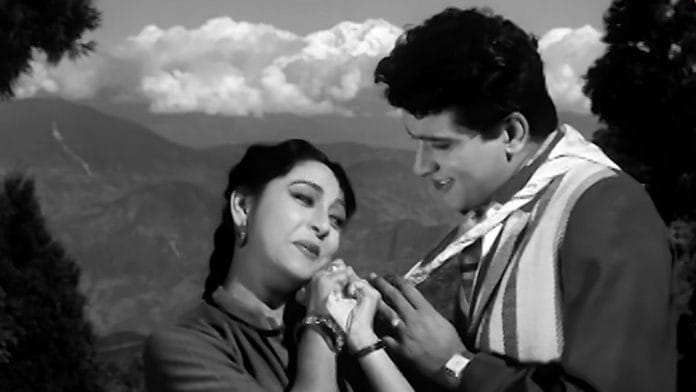What films like Panchayat (1958), Kaanch Ki Gudhiya (1961), and Reshmi Rumal (1961) failed to do for Manoj Kumar, Vijay Bhatt’s Hariyali Aur Rasta (1962) did.
The film marked Kumar’s first major box office hit, pulling him into the spotlight and establishing him as a rising star in Hindi cinema.
Hariyali Aur Rasta is a romantic drama rooted in the era’s favorite themes of love, duty, sacrifice, and moral conflict. Kumar’s earlier films had also followed the same route, but the 1962 film struck a chord with audiences through its emotional depth and longing of love.
Kumar’s portrayal of Shankar was especially memorable. With his expressive eyes and screen presence, particularly in moments of grief over lost love, the audience couldn’t help but have their hearts go out to him.
The film’s music, composed by the legendary duo Shankar-Jaikishan, was another key ingredient in its success. Songs like Allah Jane Kya Hoga and Yeh Hariyali Aur Yeh Rasta added to the narrative.
The commercial success of Hariyali Aur Rasta not only gave Kumar much-needed credibility, but also laid the foundation for future classics like Woh Kaun Thi? (1964) and Upkar (1967).
It was Bhatt’s Hariyali Aur Rasta that truly launched Kumar’s journey toward cinematic greatness.
Two kinds of women
While Manoj Kumar’s Shankar is easy on the eyes in the first half and turns into a Devdas-like figure in the second, it’s the two female leads — Mala Sinha as Shobhna and Shashikala as Rita — who drive the storyline.
Through Shobhna and Rita, the film explores two contrasting portrayals of womanhood: the self-sacrificing who puts her family’s needs above her own and the other, and a woman who chooses to live life on her own terms, independent and unapologetic.
Shankar, because of familial duty, is forced to marry Rita, leaving both his and Shobhna’s hearts broken. While he wrestles with the weight of his suppressed desires and the choices made for him, Shobhna’s quiet suffering adds a heartbreaking layer to the narrative.
Mala Sinha delivers a powerful performance, often letting her eyes speak louder than any dialogue.
Her pain is evident, whether she’s silently watching Shankar marry someone else, standing at a distance in the hospital, or witnessing his poor health from afar.
Hariyali Aur Rasta, like many films of its time, presents the idea of the “ideal flawed woman.”
Rita is painted as a hypocrite. She is organising women’s conferences and preaching the virtues of serving your husband and family, yet choosing parties and social life over her hospitalised child.
In attempting to contrast Shobhna’s virtue with Rita’s, the director leans too heavily into moral absolutism.
By the film’s end, Rita meets a tragic fate, leaving Shobhna to take her role as wife and mother.
The film’s judgement is clear: the woman who strays from domestic duties is punished.
Also read: Feroze Khan’s Dharmatma released the same year as Sholay and Deewar. It still stood out
Nature – the silent character
One of the standout features of Hariyali Aur Rasta is its cinematography by Pravin Bhatt and Bipin Gajjar.
The film was shot extensively in natural locations, primarily in the hill stations of India.
The title itself — Hariyali Aur Rasta (Greenery and the Road) — is symbolic. The roads that the characters walk on mirror the twists and turns of life, choices, and destiny. Whereas, nature is almost a silent character in the film.
The visuals of roads, lush greenery, and misty landscapes serve as both a literal and metaphorical backdrop to the narrative.
There is also a subtlety in how the filmmaker handles the central love triangle, avoiding over-the-top melodrama while still delivering emotional weight.
Hariyali Aur Rasta is more than just a love story. It shows the price individuals pay for conforming to tradition.
In a way, which is rather underplayed, the film critiques arranged marriages where individual choice is overridden by family honour.
Bhatt highlights the emotional cost of such decisions, not just for the lovers, but also for the third person — in this case Rita — who is equally caught in the web of insecurity and frustration.
To some extent, Hariyali Aur Rasta remains relevant even today.
Such films have helped reinforce the ‘good woman’ vs ‘bad woman’ binary — a narrative that still persists, often shaped by the choices women make in today’s society.”
Views are personal.
(Edited by Aamaan Alam Khan)






